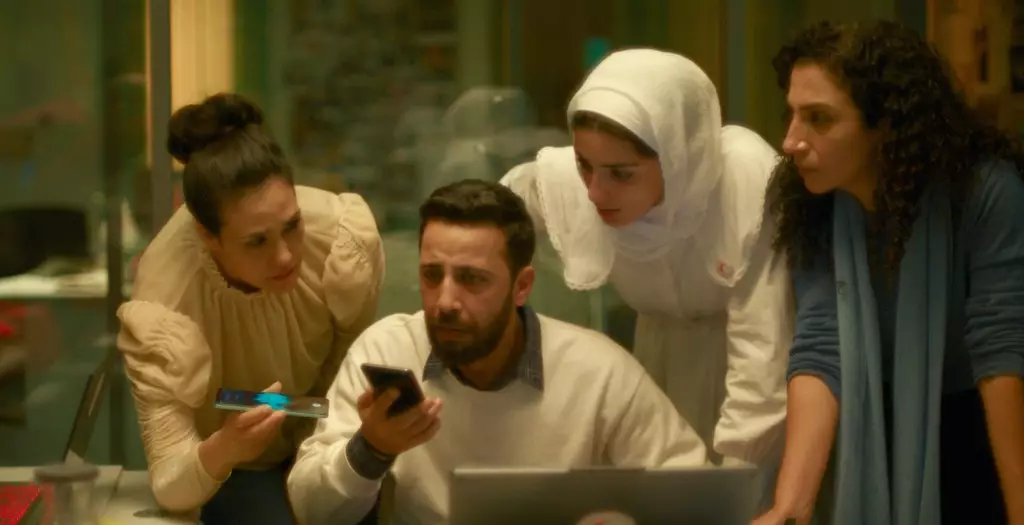Cinema, at its core, is more than entertainment; it is a potent tool for confronting uncomfortable truths and fostering empathy. When artists choose to engage with themes of conflict, suffering, and resilience, they not only illuminate the realities faced by marginalized populations but also compel viewers to reevaluate their perceptions of distant worlds. The decision by filmmaker Kaouther Ben Hania to open the inaugural Doha Film Festival with her poignant film, *The Voice of Hind Rajab*, exemplifies this idea. Rather than shying away from the brutal truth of life in Gaza, Ben Hania harnesses her craft to create a visceral experience that demands attention and provokes reflection.
By narrating the tragic story of a six-year-old girl caught in the crossfire of relentless violence, the film personalizes a conflict often reduced to numbers and political rhetoric. The blending of real emergency call recordings with scripted scenes lends authenticity to the portrayal, grounding viewers in the raw immediacy of the moment. It is this unflinching honesty that forces audiences beyond passive consumption into active engagement with the reality faced by Palestinians under occupation. Art that dares to depict suffering with honesty has the potential to shift public discourse and foster a deeper understanding of issues often cloaked in political ambiguity.
The Humanity Behind the Headlines
The opening of the festival with this emotionally charged film sends a powerful message: stories embedded in pain are also stories of resilience, hope, and the indomitable human spirit. Director Fatma Hassan Alremiahi’s words encapsulate this sentiment well, emphasizing that Hind’s voice is emblematic of countless others whose lives have been upended. Cinema becomes a bridge—an empathetic connection that can traverse borders, beliefs, and biases. It reminds us that behind every headline, every statistic, there are human beings with stories that merit recognition and compassion.
Furthermore, the choice to premiere *The Voice of Hind Rajab* at a film festival designed to celebrate global storytelling underscores the importance of elevating voices from conflict zones. Far too often, narratives of war are mediated through political lenses or sanitized for mass consumption. Ben Hania’s decision to humanize her subject matter is a bold challenge to these conventions, asserting that truth and emotional honesty should be at the forefront of artistic expression.
Cinema as a Catalyst for Justice and Change
The timing of this film’s debut, amid escalating violence and international condemnation of Israel’s military campaign in Gaza, adds another layer of significance. Art does not exist in a vacuum; it reflects societal tensions and, at times, influences them. By spotlighting the trauma of Gaza’s civilians, especially children, *The Voice of Hind Rajab* pushes audiences to confront the human cost of geopolitical conflicts. It underscores how military operations, driven by complex political motivations, ripple through everyday lives, often leaving the most vulnerable devastated.
This film’s recognition and accolades—such as its standing ovation at Venice—demonstrate cinema’s capacity to resonate globally. When Hollywood stars like Joaquin Phoenix and Rooney Mara support a project like this, they help amplify its message on the world stage. It becomes more than a documentary; it transforms into a call to action. Cinema here becomes a vessel for social justice—a means to galvanize awareness, inspire activism, and challenge complacency.
Personal Courage and Artistic Integrity
Kaouther Ben Hania’s accomplishments as a filmmaker highlight her unwavering commitment to truth and artistic innovation. Her previous successes, including Tunisia’s first Oscar nomination for *The Man Who Sold His Skin*, attest to her skill in provoking thought while maintaining an aesthetic integrity. Her choice to focus on such a delicate and painful subject reveals her courage to confront her own society’s complexities and to give voice to the voiceless.
Her cinematic approach reflects a broader trend among contemporary artists: the recognition that film can be a force for societal reflection and change. By daring to tell stories that challenge viewers, these filmmakers serve as cultural ambassadors—disrupting complacency and sparking difficult conversations that are ultimately necessary for progress. Their work exemplifies how creativity, when wielded responsibly, can be a catalyst for empathy and revolution.
Broader Implications for the Art World
The debut of *The Voice of Hind Rajab* at the first edition of the Doha Film Festival signals a pivotal moment in the evolution of global cinema. It illustrates a growing willingness within the film industry to embrace stories rooted in conflict and human resilience, recognizing their importance beyond mere entertainment. The festival’s expanded international scope and substantial prize offerings suggest an ambition to foster diverse, impactful storytelling from around the world.
Ultimately, Ben Hania’s work and the festival’s focus embody a vital message: that cinema has the power and responsibility to shine a light on the world’s darkest corners. Films like *The Voice of Hind Rajab* are not just artistic achievements—they are moral statements. They remind us that storytelling is perhaps the most effective way to foster understanding, challenge injustice, and inspire change. In a world fraught with violence and division, cinema that champions truth and empathy offers a beacon of hope—a testament to art’s enduring power to confront the most profound human truths.
